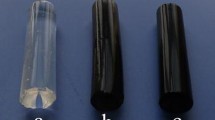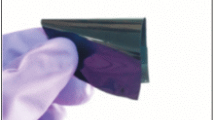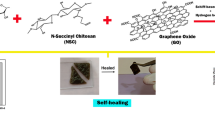Abstract
Creating flexible, high-strength hydrogels from harmless, low-cost natural polymers is an area of intense research today due to their potential applications in the biomedical field, which demands materials with ambivalent physicochemical features. In particular, great efforts were devoted to the preparation of sustainable biohydrogels, composed of hydrophilic networks of renewable, biocompatible, biodegradable, and low-cost biopolymers. Bionanocomposites are a promising synthetic approach to combine specific multifunctional materials with targeted physicochemical properties. Novel bionanocomposite hydrogels were designed by combining both chondroitin sulfate (CS) as well as gelatin (GE) obtained from the waste generated by the fish industries to form double fibre networks with tailored properties. In addition, hybrid bionanocomposites were achieved by introducing graphene nanoparticles (xGnP) into the double fibrillar network (GE/CS) to enhance the physicochemical properties. The bionanocomposite nanostructures were characterized by Fourier transform infrared spectroscopy (FTIR), differential scanning calorimeter (DSC) while their rheological properties and thermal stability were determined by rheological and thermogravimetric analyses (TGA), respectively. The likely interactions between CS and gelatin in the GE/CS hydrogel network were proved by ATR-FTIR spectroscopy. The incorporation of xGnP improved the mechanical properties of the GE/CS fibrillary network by an order of magnitude in the shear storage modulus. Eventually, the generated bionanocomposites hydrogels and bionanocomposite hybrid hydrogels have promising potential for applications in many biomedical fields, including drug delivery and tissue engineering by mimicking tissue extracellular matrix components such as the gelatin for collagen and the CS in the cartilage.





Similar content being viewed by others
Data availability
The data presented in this study are available on request from the corresponding author.
References
R. Yasmina, M. Shaha, S. Ahmad Khan, R. Ali, Gelatin nanoparticles: a potential candidate for medical applications. Nanotechnol Rev. 6(2), (2017). https://doi.org/10.1515/ntrev-2016-0009
R. Song, M. Murphy, C. Li, K. Ting, C. Soo, Z. Zheng, Drug Design. Dev. Ther. 12, (2018). https://doi.org/10.2147/DDDT.S165440
F.M. Chen, X. Liu, Advancing biomaterials of human origin for tissue engineering. Progress Polym. Sci. (2016). https://doi.org/10.1016/j.progpolymsci.2015.02.004
B. Caterson, FellMuir Lecture: Chondroitin Sulphate Glycosaminoglycans: Fun for Some and Confusion for Others. 93(1), (2012). https://doi.org/10.1111/j.1365-2613.2011.00807.x
M. Yeh, K. Cheng, C. Hu, Y. Huang, J. Young, Novel Protein-Loaded Chondroitin Sulfate–Chitosan Nanoparticles. Preparation and Characterization. Acta Biomaterialia. 7, (2011). https://doi.org/10.1016/j.actbio.2011.06.026
J.J. Knapik, R. Pope, S.S. Hoedebecke, B. Schram, R. Orr, Effects of Oral Chondroitin Sulfate on Osteoarthritis-Related Pain and Joint Structural Changes. 1, (2019)
L. Alrubaiy, K.K. Al-Rubaiy, Skin Substitutes: A Brief Review of Types and Clinical Applications. Oman Med. J. 1, (2009). https://doi.org/10.5001/omj.2009.2
S.M. Riha, M. Maarof, M.B. Fauzi, Synergistic Effect of Biomaterial and Stem Cell for Skin Tissue Engineering in Cutaneous Wound Healing: A Concise Review. 10, (2021). https://doi.org/10.3390/polym13101546
A. Sintov, N. Di-Capua, A. Rubinstein, Cross-Linked Chondroitin Sulphate: Characterization for Drug Delivery Purposes. 6, (1995). https://doi.org/10.1016/0142-9612(95)98820-5
J. Xi, J. Qin, L. Fan, Chondroitin Sulfate Functionalized Mesostructured Silica Nanoparticles as Biocompatible Carriers for Drug Delivery. Int. J. Nanomed. 13, (2012). https://doi.org/10.2147/IJN.S34128
S. Petros, T. Tesfaye, M. Ayele, A Review on Gelatin Based Hydrogels for Medical Textile Applications. J. Eng. 12, (2020). https://doi.org/10.1155/2020/8866582
B. Jeong, S.W. Kim, Y.H. Bae, Thermosensitive Sol–Gel Reversible Hydrogels. Adv. Drug Deliv. Rev. 15, (2002). https://doi.org/10.1016/s0169-409x(01)00242-3
H. Nassira, A. Sánchez-Ferrer, J. Adamcik, S. Handschin, H. Mahdavi, N.T. Qazvini, R. Mezzenga, Gelatin–Graphene Nanocomposites with Ultralow Electrical Percolation Threshold. Adv. Mater. 7, (2016). https://doi.org/10.1002/adma.201601115
Y. Lee, J.W. Bae, J.W. Lee, W. Suh, K.D. Park, Enzyme-Catalyzed in Situ Forming Gelatin Hydrogels as Bioactive Wound Dressings: Effects of Fibroblast Delivery on Wound Healing Efficacy. J. Mater. Chem. B. 7, (2014). https://doi.org/10.1039/C4TB01111B
M. Foox, M. Zilberman, Drug Delivery from Gelatin-Based Systems. Expert Opin. Drug Deliv. 9, (2015). https://doi.org/10.1517/17425247.2015.1037272
G.V.N. Rathna, Gelatin Hydrogels: Enhanced Biocompatibility, Drug Release and Cell Viability. J. Mater. Sci. Mater. Med. 19, (2008). https://doi.org/10.1007/s10856-007-3334-9
Y. Marois, N. Chakf, X. Deng, M. Marois, M.W. King, R. Guidoin, Carbodiimide Cross-Linked Gelatin: A New Coating for Porous Pol.Yester Arterial Prostheses. Biomaterials. 15, (1995)
J.S.A. Gonz, J. Paz, H.J. Salavagione, J. Carretero-González, R. Hernández, Compact Polyelectrolyte Hydrogels of Gelatin and Chondroitin Sulfate as Ion’s Mobile Media in Sustainable All-Solid State Electrochemical Devices. Mater. Adv. 1, (2020). https://doi.org/10.1039/D0MA00514B
G. Thakur, D. Rousseau, Hydrogels: Characterization, Drug Delivery, and Tissue Engineering Applications. Drug Deliv. 28, (2014)
Q. Zhang, Z. Wu, N. Li, Y. Pu, B. Wang, T. Zhang, J. Tao, Advanced review of graphene-based nanomaterials in drug delivery systems: Synthesis, modification, toxicity and application. Mater. Sci. Eng. (2017). https://doi.org/10.1016/j.msec.2017.03.196
P. Shende, S. Augustine, B. Prabhakar, A review on graphene nanoribbons for advanced biomedical applications. Carbon Lett. 7, (2020). https://doi.org/10.1007/s42823-020-00125-1
J. Yi, G. Choe, J. Park, J.Y. Lee, Graphene oxide-incorporated hydrogels for biomedical applications. Polym. J. 8, (2020). https://doi.org/10.1038/s41428-020-0350-9
K. Liu, J.J. Zhang, F.-F. Cheng, T.T. Zheng, C. Wang, J.J. Zhu, Green and facile synthesis of highly biocompatible graphene nanosheets and its application for cellular imaging and drug delivery. J. Mater. Chem. 32, (2011). https://doi.org/10.1039/C1JM10749F
M. Bramini, G. Alberini, E. Colombo, M. Chiacchiaretta, M. L. DiFrancesco, J.F. Maya-Vetencourt, L. Maragliano, F. Benfenati, F. Cesca, Interfacing Graphene-Based Materials With Neural Cells. Front. Syst. Neurosci. 12, (2018). https://doi.org/10.3389/fnsys.2018.00012
J. Park, J.H. Choi, S. Kim, I. Jang, S. Jeong, J.Y. Lee, Micropatterned conductive hydrogels as multifunctional muscle-mimicking biomaterials: Graphene-incorporated hydrogels directly patterned with femtosecond laser ablation. Acta Biomaterialia. 97, (2019). https://doi.org/10.1016/j.actbio.2019.07.044
R. Arvidsson, M. Boholm, M. Johansson, M.L. Montoya, “Just Carbon”: Ideas About Graphene Risks by Graphene Researchers and Innovation Advisors. Nanoethics. 3, (2018). https://doi.org/10.1007/s11569-018-0324-y
K. Joshi, B. Mazumder, P. Chattopadhyay, N.S. Bora, D. Goyary, S. Karmakar, Graphene Family of Nanomaterials: Reviewing Advanced Applications in Drug delivery and Medicine. Curr. Drug Delivery. 3, (2019). https://doi.org/10.2174/1567201815666181031162208
S.C. Sousa, J.A. Vázquez, R.I. Pérez-Martín, A.P. Carvalho, A.M. Gomes, Valorization of By-Products from Commercial Fish Species: Extraction and Chemical Properties of Skin Gelatins. Molecules. 9, (2017). https://doi.org/10.3390/molecules22091545
J.A. Vázquez, M. Blanco, J. Fraguas, L. Pastrana, R. Pérez-Martín, Optimisation of the Extraction and Purification of Chondroitin Sulphate from Head By-Products of Prionace Glauca by Environmental Friendly Processes. Food Chem. 8, (2016)
C. Hermida-Merino, Tuning the Electrical Conductivity of Exfoliated Graphite Nanosheets Nanofluids by Surface Functionalization. Soft Matter. 9, (2017)
C. Hermida-Merino, F. Pardo, G. Zarca, J.M.M. Araújo, A. Urtiaga, M.M. Piñeiro, A.B. Pereiro, Integration of Stable Ionic Liquid-Based Nanofluids into Polymer Membranes. Part I: Membrane Synthesis and Characterization. Nanomaterials. 17, (2021)
S. Jo, S. Kim, I. Noh, Synthesis of In Situ Chondroitin Sulfate Hydrogel through Phosphine-Mediated Michael Type Addition Reaction. Macromol. Res. 20, (2012)
A.P.V. Oliveira, V. de A. Feitosa, J. Martins, de Oliveira, A.L. Coelho, Characteristics of chondroitin sulfate extracted of tilapia (oreochromis niloticus) processing. Proc. Eng. 7, (2017).
X. Kong, Chondroitin Sulfate/Polycaprolactone/Gelatin Electrospun Nanofibers with Antithrombogenicity and Enhanced Endothelial Cell Affinity as a Potential Scaffold for Blood Vessel Tissue Engineering. Nanoescale Res. Lett. 11, (2021)
A. Galus, J.-M. Mallet, D. Lembo, V. Cagno, H. Lortat-Jacob, K. Bouchemal, Supporting Data - Hexagonal-Shaped Chondroitin Sulfate Self-Assemblies Have Exalted Anti-HSV-2 Activity. Carbohydrate Polym. 10, (2016)
E. Jeevithan, B. Bao, Y. Bu, Y. Zhou, Q. Zhao, W. Wu, Type II Collagen and Gelatin from Silvertip Shark (Carcharhinus Albimarginatus) Cartilage: Isolation, Purification, Physicochemical and Antioxidant Properties. Marine Drugs. 7, (2014). https://doi.org/10.3390/md12073852
G. Sundaresan, R.J.J. Abraham, V. Appa Rao, R. Narendra Babu, V. Govind, M.F. Meti, Established Method of Chondroitin Sulphate Extraction from Buffalo (Bubalus Bubalis) Cartilages and Its Identification by FTIR. J Food Sci Technol. 9, (2018). https://doi.org/10.1007/s13197-018-3253-4
G.S. Al-Saidi, A. Al-Alawi, M.S. Rahman, N. Guizani, Fourier transform infrared (FTIR) spectroscopic study of extracted gelatin from shaari (Lithrinus microdon) skin: Effects of extraction conditions. Int. Food Res. J. 3, (2012)
G. Shengju, L. Qing, et al, Enhanced mechanical properties and gelling ability of gelatin hydrogels reinforced with chitin whiskers. Food Hydrocolloids. 75, (2017). https://doi.org/10.1016/j.foodhyd.2017.09.023
A. Baseer, A. Koenneke, J. Zapp, S.A. Khan, M. Scheider, Design and Characterization of Surface-Crosslinked Gelatin Nanoparticles for the Delivery of Hydrophilic Macromolecular Drugs. Macromol. Chem. Phys. 18, (2019). https://doi.org/10.1002/macp.201900260
Hydrophilic Drug Delivery based on Gelatin Nanoparticles. (2018). https://doi.org/10.22028/D291-27268
C. Hermida-Merino, M. Pérez-Rodríguez, M.M. Piñeiro, M.J. Pastoriza-Gallego, Tuning the electrical conductivity of exfoliated graphite nanosheets nanofluids by surface functionalization. Soft Matter. 18, (2017). https://doi.org/10.1039/C7SM00218A
Y. Ye, X. Hu, A pH-Sensitive Injectable Nanoparticle Composite Hydrogel for Anticancer Drug Delivery. J. Nanomater. (2016). https://doi.org/10.1155/2016/9816461
A.M. Dimiev, L.B. Alemany, J.M. Tour, Graphene Oxide. Origin of Acidity, Its Instability in Water, and a New Dynamic Structural Model. ACS Nano. 1, (2012). https://doi.org/10.1021/nn3047378
C.S. Nunes, Chitosan/Chondroitin Sulfate Hydrogels Prepared in [Hmim][HSO4] Ionic Liquid. Carbohydrate Polym. 8, (2017)
N.R. Jadhav, R.S. Tone, P.V. Irny, S.J. Nadaf, Development and characterization of gelatin based nanoparticles for targeted delivery of zidovudine. Int. J. Pharm. Investig. 3, (2013). https://doi.org/10.4103/2230-973X.119213
C. Hermida-Merino, A.B. Pereiro, J.M.M. Araújo, C. Gracia-Fernández, J.P. Vallejo, L. Lugo, M.M. Piñeiro, Graphene IoNanofluids. Therm. Struct. Characterization. 11, (2019). https://doi.org/10.3390/nano9111549
Acknowledgements
The authors thank CACTI (University of Vigo) for technical assistance.
Funding
The authors acknowledge the financial support received from Project KET4F-Gas-SOE2/P1/P0823, which is co-financed by the European Regional Development Fund within the framework of Interreg Sudoe Programme and project PID2019-105827RB-I00–Agencia Estatal de Investigación, Spain.
Author information
Authors and Affiliations
Corresponding authors
Ethics declarations
Conflict of interest
The authors declare no competing interests.
Supplementary Information
Below is the link to the electronic supplementary material.
Rights and permissions
About this article
Cite this article
Hermida-Merino, C., Valcarcel, J., Vázquez, J.A. et al. Combined gelatin-chondroitin sulfate hydrogels with graphene nanoparticles. emergent mater. 5, 755–764 (2022). https://doi.org/10.1007/s42247-021-00303-5
Received:
Accepted:
Published:
Issue Date:
DOI: https://doi.org/10.1007/s42247-021-00303-5




